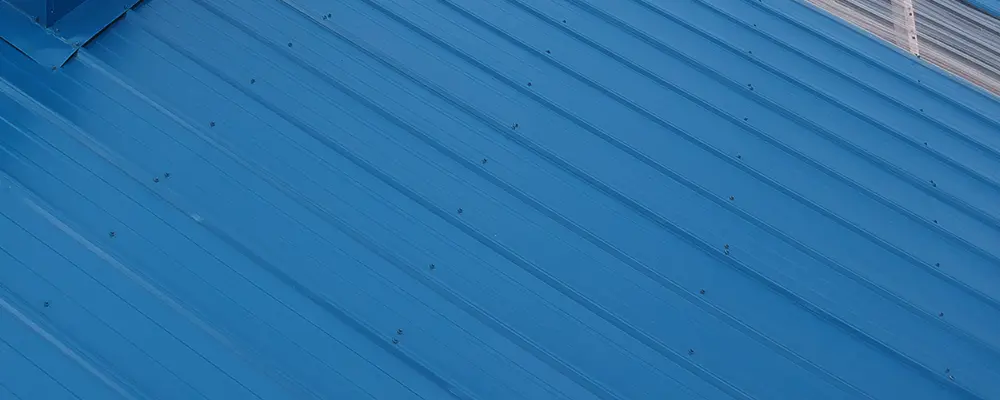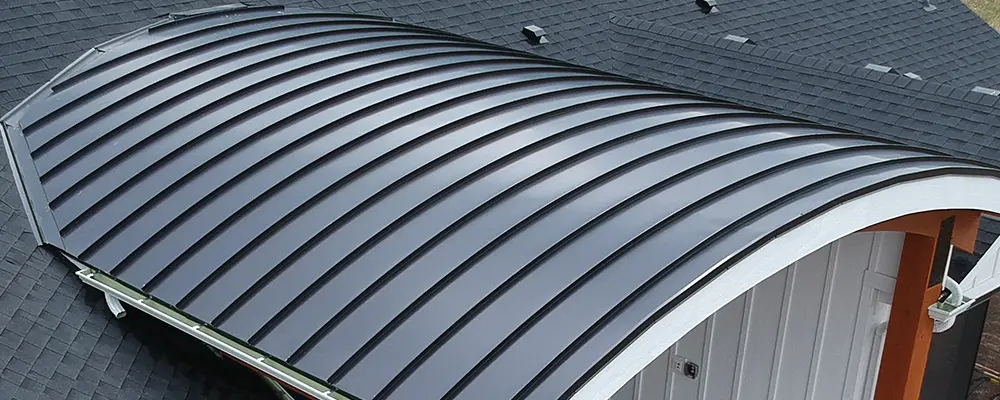What is an Exposed Fastener Metal Roof
Exposed metal fastener roofs are roofs made from long sheets of metal where the fasteners (screws) are visable. Screws are used to secure the roof down to the roof deck. Various profiles of exposed metal fastener roofs are available, including corrugated/PBC and various Ribbed versions. When we install an exposed fastener metal roof, we make sure the fasteners are all aligned. This makes for an appealing pattern across your new metal roof. Most people do not find the exposed fasteners visually unappealing.

Pros of an Exposed Fastener Roof
- Less Expensive Than Concealed Fastener
- DIY-Friendly
- Availability
- Wider Panels
Because exposed fastener metal roofing sheets are often thinner than concealed fastener metal roof, the materials are often less expensive. What’s more, since exposed fastener sheets are wider, it takes fewer of them to cover a roof, which also reduces the cost. Exposed fastener metal roofing is also readily available. Homeowners can often find a small assortment of metal roofing sheets at their local Lowe’s, Ace, or other hardware stores. They’re also more DIY-friendly, since they’re fairly straightforward to install.
Cons
- Prone to Leaks
- Higher Maintenance
- More Penetrations
- Thinner Sheets (26, 29ga)
- Lower Quality
- Restricted Movement
Metal roofs expand and contract in the heat and cold. Over the length of a 100′ metal roof, it will expand up to 12 inches. You read that right. A 100′ metal roofing panel in a cool summer morning in Colorado will grow to 101′ long at the end of a long hot summer day. This is a great amount of stress on the fasteners/screws used to secure the metal roof down. As the metal expands and contracts, the holes in the sheet metal will enlarge since the screws are fastened in place. In addition, the rubber washers used in the screws become dry and crack over time. As a result, an exposed fastener metal roof requires more maintenance and is prone to leaks.
Exposed fastener metal roofs are often lower quality and thinner sheets of metal. Ribbed exposed fastener metal roofing sheets from your Big Box stores are often 29 or 31 gauge (the larger the number, the thinner the metal). Compared to concealed fastener metal roofing sheets, which are offered in either 24 or 26 gauge. Thicker metal is more durable than thinner metal.
Exposed fastener metal roofing requires fasteners directly in the roof covering, and more of them. More penetrations means more holes in your roof. More holes means more opportunities for leaks.
What is a Concealed Fastener Metal Roof
Concealed fastener metal roofs are also long sheets of metal. However, their fasteners are hidden from view beneath the previous sheet of metal roofing. Concealed fastener metal roofs are commonly called Standing Seam, and are available in fewer profiles. Which profile is used is often determined by the roofing company. Standing seam or concealed fastener metal roofs are often preferred over exposed fastener metal roofs since they offer a cleaner look.

Pros of a Concealed Fastener Roof
- Cleaner Appearance
- Fewer Fasteners
- Fewer Leaks
- Fewer Seams
- Thicker Metal (24 and 26ga)
Concealed fastener metal roofing uses separates clips which are secured to the roof deck. These clips, which the metal sheets are clipped or snapped to, require fewer screws or penetrations. What’s more, these screwed-in clips are hidden, not only from view, but also protected from UV radition, solar heat, and cold. As a result, they expand and contract much less compared to exposed fastener metal sheets.
Concealed fastener metal roofs are available in a thicker gauge than exposed fastener metal roofs. When measuring the thickness of metal, the smaller the number, the thicker it is. Concealed fastener metal roofing sheets are available in either 24 or 26 gauge. Exposed fastener metal roofing, on the other hand, is offered in 26, 29, and 31 gauge. 31 gauge is common in big box stores. Thicker metal will hold-up better than thinner metal, for example, to hail. Therefore, it will last longer.
Cons
- More Expensive Than Concealed Fastener
- Fewer Profiles
- Not DIY-Friendly
- Availability
Because concealed fastener metal roofing often uses thicker gauge metal, and the sheets are narrower than exposed fastener roofing, it often costs more. Standing seam panels are also not available at your local hardward store. This is perhaps because it’s not DIY-friendly and requires special knowledge. Standing seam is also only available in 1 profile – standing seam. The seam height only varies slightly, as does the width of the panels.
Primary Differences Between Exposed vs Concealed Fastener Metal Roofs
- Different Profiles
- Cost Difference
- Amount of Maintenance
- DIY
MBCI offers 10 different profiles of exposed fastener metal roofing panels. Profiles include 2 corrugated and various versions of ribbed. Compared to basically 1 concealed fastener/standing seam metal roofing profile. Standing seam/concealed fastener roofs often cost more but require less maintenance. Exposed fastener metal roofing panels are much more DIY-friendly than standing seam.
What are the Similarities
- Wide Range of Colors
- Cool/Energy-Efficient
- Long Lasting
- Durable
- Recyclable
Regardless of which sheet metal roof you install, they all come in a wide range of colors. For example, Imperial Rib from American Building Components comes in over a dozen colors. Our own standing seam/concealed fastener metal roofing comes in over two dozen colors. Also, all sheet metal roofing is much more energy-efficient than even the coolest asphalt shingle roof. Metal is also much more durable than traditional asphalt shingles. Therefore, will last a lot longer. What’s more, metal is 100% recyclable in our area. Asphalt shingles are not.
How to Choose
Pitch
You can have an exposed fastener metal roof if your roof’s pitch is 3/12 or greater. Less than this and snow can build-up, causing the rubber gaskets to contract too much and crack. If your roof is not flat, but less than 3/12, choose standing seam/concealed fastener metal roof. Unsure what your roof’s pitch is? No problem. Contact us for a free consultation.
Choose a standing seam/concealed fastener metal roof if
- your roof is low-sloped but not flat
- it’s going over your house (we generally don’t recommend exposed fastener metal roofs for homes, since they’re more prone to leaks)
- you want your roof to last as long as possible
- you want a cleaner looking roof
Choose an exposed fastener metal roof if
- the new roof is for your barn, chicken coop, or other outbuilding
- you’re installing the roof yourself
- you don’t mind the visual of the exposed screws
- you don’t mind the higher maintenance
The Bottom Line
The big differences between exposed and concealed fastener metal roofs, or standing seam and corrugated/PBC or ribbed roofing panels, is maintenance, price, and appearance. Exposed fastener metal roofs are perfect for barns, where there’s less or no electrical beneath it. Your horse probably won’t mind the occasional water drip if your ribbed roof leaks on occasion. However, you might sitting in your house. Standing seam/concealed fastener metal roofs are ideal for homes since they require less maintenance. Sheet metal roofing is the best roof for your farm.
If you’re unsure which metal roof is right for you, contact us for a free consultation and estimate. We’re more than happy to discuss with you all the pros and cons of exposed and concealed fastener metal roofs.
